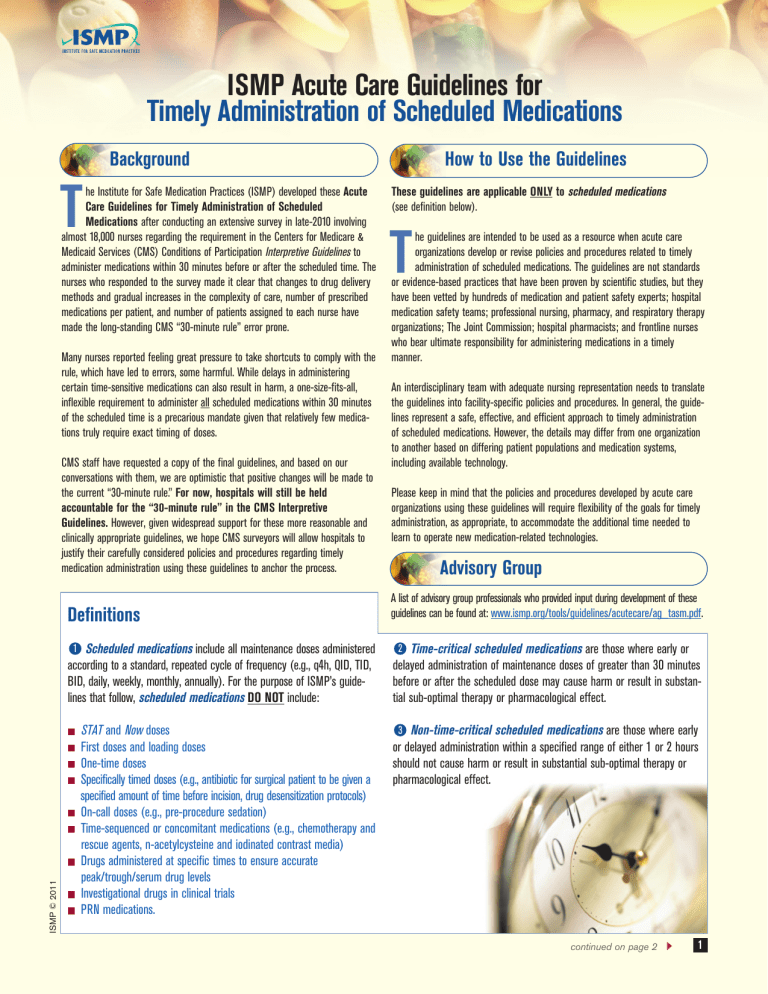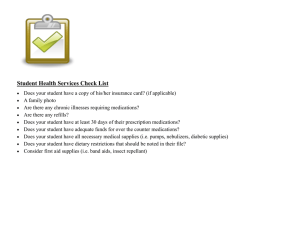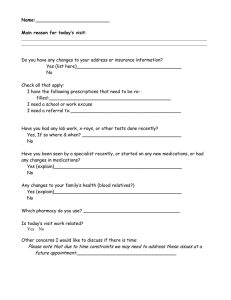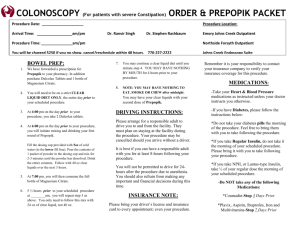ISMP Acute Care Guidelines for Timely Administration of Scheduled

ISMP Acute Care Guidelines for
Timely Administration of Scheduled Medications
Background How to Use the Guidelines
T he Institute for Safe Medication Practices (ISMP) developed these Acute
Care Guidelines for Timely Administration of Scheduled
Medications after conducting an extensive survey in late-2010 involving almost 18,000 nurses regarding the requirement in the Centers for Medicare &
Medicaid Services (CMS) Conditions of Participation Interpretive Guidelines to administer medications within 30 minutes before or after the scheduled time. The nurses who responded to the survey made it clear that changes to drug delivery methods and gradual increases in the complexity of care, number of prescribed medications per patient, and number of patients assigned to each nurse have made the long-standing CMS “30-minute rule” error prone.
Many nurses reported feeling great pressure to take shortcuts to comply with the rule, which have led to errors, some harmful. While delays in administering certain time-sensitive medications can also result in harm, a one-size-fits-all, inflexible requirement to administer all scheduled medications within 30 minutes of the scheduled time is a precarious mandate given that relatively few medications truly require exact timing of doses.
CMS staff have requested a copy of the final guidelines, and based on our conversations with them, we are optimistic that positive changes will be made to the current “30-minute rule.” For now, hospitals will still be held accountable for the “30-minute rule” in the CMS Interpretive
Guidelines.
However, given widespread support for these more reasonable and clinically appropriate guidelines, we hope CMS surveyors will allow hospitals to justify their carefully considered policies and procedures regarding timely medication administration using these guidelines to anchor the process.
These guidelines are applicable ONLY to scheduled medications
(see definition below).
T he guidelines are intended to be used as a resource when acute care organizations develop or revise policies and procedures related to timely administration of scheduled medications. The guidelines are not standards or evidence-based practices that have been proven by scientific studies, but they have been vetted by hundreds of medication and patient safety experts; hospital medication safety teams; professional nursing, pharmacy, and respiratory therapy organizations; The Joint Commission; hospital pharmacists; and frontline nurses who bear ultimate responsibility for administering medications in a timely manner.
An interdisciplinary team with adequate nursing representation needs to translate the guidelines into facility-specific policies and procedures. In general, the guidelines represent a safe, effective, and efficient approach to timely administration of scheduled medications. However, the details may differ from one organization to another based on differing patient populations and medication systems, including available technology.
Please keep in mind that the policies and procedures developed by acute care organizations using these guidelines will require flexibility of the goals for timely administration, as appropriate, to accommodate the additional time needed to learn to operate new medication-related technologies.
Advisory Group
A list of advisory group professionals who provided input during development of these guidelines can be found at: www.ismp.org/tools/guidelines/acutecare/ag_tasm.pdf
.
Definitions
1 Scheduled medications include all maintenance doses administered according to a standard, repeated cycle of frequency (e.g., q4h, QID, TID,
BID, daily, weekly, monthly, annually). For the purpose of ISMP’s guidelines that follow, scheduled medications DO NOT include:
2 Time-critical scheduled medications are those where early or delayed administration of maintenance doses of greater than 30 minutes before or after the scheduled dose may cause harm or result in substantial sub-optimal therapy or pharmacological effect.
STAT and Now doses
First doses and loading doses
One-time doses
Specifically timed doses (e.g., antibiotic for surgical patient to be given a specified amount of time before incision, drug desensitization protocols)
On-call doses (e.g., pre-procedure sedation)
Time-sequenced or concomitant medications (e.g., chemotherapy and rescue agents, n-acetylcysteine and iodinated contrast media)
Drugs administered at specific times to ensure accurate peak/trough/serum drug levels
Investigational drugs in clinical trials
PRN medications.
3 Non-time-critical scheduled medications are those where early or delayed administration within a specified range of either 1 or 2 hours should not cause harm or result in substantial sub-optimal therapy or pharmacological effect.
1 continued on page 2
ISMP Acute Care Guidelines for Timely Administration of Scheduled Medications
continued from page 1
Time-Critical Scheduled Medications
1 Identify a hospital-specific list
Identify a hospital-specific list of time-critical scheduled medications . While this list will include a limited number of drugs, a universal list is not desirable because hospitals that treat different patient populations (e.g., mental health, oncology, transplant patients, pediatrics, premature infants) may need to include different medications to address risks. Similarly, some hospitals that serve very diverse patient populations may decide to identify both hospital-wide and unit-specific time-critical scheduled medications .
Examples of time-critical scheduled medications that should be included on all hospitals’ lists include:
2 Medications administered more frequently than daily but not more frequently than every 4 hours (e.g., BID, TID, q4h, q6h)
Administer these medications within 1 hour before or after the scheduled time.
Current information technology associated with medication use may require vendor updates to: accommodate more than a single time interval to trigger an alert for delayed and early doses with bar-coding technology; change the appearance of a medication entry for delayed doses in electronic medication administration records (eMARs); and set different time limits for the removal of scheduled medications from automated dispensing cabinets. Challenges also exist with highlighting time-critical scheduled medications on eMARs and differentiating between first doses and subsequent scheduled doses when using these technologies. ISMP is aware of these limitations and has been encouraging vendors to address them in updated versions of their technology.
Medications with a dosing schedule more frequent than every 4 hours
Scheduled (not prn) opioids used for chronic pain or palliative care (fluctuations in the dosing interval may result in unnecessary break-through pain)
Immunosuppressive agents used for the prevention of solid-organ transplant rejection or to treat myasthenia gravis
Medications that must be administered apart from other medications
(e.g., antacids and fluoroquinolones).
Certain medications that require administration within a specified period of time before, after, or with meals—for example, rapid-, short-, or ultra-short-acting insulins, certain oral antidiabetic agents (e.g., acarbose, nateglinide, repaglinide, glimepiride), alendronate, and pancrelipase.
Medications administered around mealtimes require nursing judgment regarding the actual scheduled time of administration, which may fluctuate based on meal delivery time, actual consumption of the meal, and the patient’s condition.
Table 1 summarizes the guidelines and Table 2 (page 3) provides brief guidance regarding appropriate allocation of human resources, the content of policies and procedures related to timely drug administration, and the evaluation associated with event reporting and data analysis.
Table 1.
Acute Care Guidelines for Timely Administration of
Scheduled Medications
Type of Scheduled Medication Goals for Timely Administration
Time-Critical Scheduled Medications
Hospital-defined time-critical medications*
Administer at the exact time indicated when necessary (e.g., rapid-acting insulin), otherwise, within 30 minutes before or after the scheduled time *Limited number of drugs where delayed or early administration of more than 30 minutes may cause harm or sub-therapeutic effect
Because some scheduled medications can be time-critical for certain patients given their diagnoses (e.g., parenteral antiinfective agents for a patient with worsening sepsis), the list may include some drugs that are time-critical only when used for a specific diagnosis or indication. Policies should allow prescribers, pharmacists, or nurses to declare any scheduled medication to be time-critical (i.e., must be given at exact time or within
30 minutes before or after the scheduled time) by including this designation with the medication order and/or medication administration record (MAR) entry.
Includes but not limited to:
Medications with a dosing schedule more frequent than every 4 hours
Non-Time-Critical Scheduled Medications
Daily, weekly, monthly medications
Within 2 hours before or after the scheduled time
Medications prescribed more frequently than daily, but no more frequently than every 4 hours
Within 1 hour before or after the scheduled time
2 Establish guidelines for time-critical medications
Establish guidelines that facilitate administration of the hospital-identified, time-critical scheduled medications at the exact time indicated when necessary or within
30 minutes before or 30 minutes after the scheduled time (or more exact timing when indicated, as with rapid-, short-, and ultra-short-acting insulins). MAR entries for hospital-identified time-critical scheduled medications should be designated to remind staff that these drugs require meticulous attention to timely administration.
Medical Staff Approval
Obtain medical staff approval of all policies and procedures related to timely administration of scheduled medications.
First Doses
1
Non-Time-Critical Scheduled Medications
Establish guidelines for daily, weekly, or monthly medications
Administer these medications within 2 hours before or after the scheduled time.
Although it is generally safe to administer daily/weekly/monthly medications within a timeframe that exceeds 2 hours, ISMP recommends keeping the timeframe to 2 hours before or after the scheduled time to prevent accidental omission of doses that might be more easily forgotten if delayed more than 2 hours.
Although not associated with the timing of scheduled medications, hospitals should also define targeted timeframes for administering first doses and loading doses of key medications, such as IV antiinfective agents, IV anticoagulants, and IV antiepileptic medications, where timeliness is critical (e.g., an emergency department patient with suspected sepsis should not wait several hours for the administration of a prescribed antiinfective).
While timely administration of first or loading doses of these drugs may be critical, many are not necessarily time-critical when it comes to subsequent maintenance doses. The targeted timeframes for first or loading doses of medications should be accompanied by procedures that facilitate achievement of the administration time goals.
continued on page 3
2
www.ismp.org/Newsletters/acutecare/articles/20110519.asp
ISMP Acute Care Guidelines for Timely Administration of Scheduled Medications
continued from page 2
Table 2.
Supporting Operational Guidelines for Timely Administration of Scheduled Medications
Topic
Maintain adequate staffing levels
Description
Maintain adequate staffing levels in the pharmacy and patient care units, based on workload and patient acuity, to facilitate timely order review, dispensing, drug administration, and patient monitoring.
Consider medication administration when making patient assignments
Use of automated dispensing cabinets (ADCs)
Justification of early or late administration
When planning nursing staff assignments for patient care, consider the following patient acuity factors: types of prescribed medications; quantity of time-critical medications; complexity of drug administration (e.g., preparing the drug, programming drug delivery devices, verification processes, administration procedures); total number of daily medications; frequency of drug administration; and the patient’s ability to swallow oral medications.
If using ADCs, ensure the number of cabinets on patient care units facilitates both safe (e.g., removal of one patient’s medications at a time) and timely (e.g., minimal waiting time to remove medications) drug administration.
Identify and clearly define justifiable reasons that time-critical and non-time-critical medications may be given early or late, or may be omitted (e.g., patient absence from unit, nausea/vomiting).
MAR documentation
Reference MARs eMAR alerts
Standard administration schedules
Procedure to follow if medication administration is early or delayed
Event reporting
Data analysis
Require staff who administer medications to document the exact time the drug was administered, rather than just initialing the MAR entry, to provide nurses with the information they need to evaluate the actual dosing interval before administering medications early or late. If a medication was administered early or late, or has been omitted, require staff to document the reason. Ensure electronic and paper MARs provide sufficient space and prompts for this documentation.
Require staff administering medications to always reference MARs that show times of the previously administered doses. This helps to avoid early administration of a dose that was previously administered late, resulting in a dosing interval that is too short (e.g., if a 9 a.m. dose of a maintenance opioid pain medication is given at 10 a.m., and the 1 p.m. dose is given at 12 p.m., the dosing interval is just 2 hours, thus risking over-sedation).
When possible, define and configure (with vendor support as needed) eMAR alerts to show doses that will soon be overdue, that are beyond defined time limits or have been omitted, and to highlight previous doses that have been delayed/omitted.
Adhere to standard drug administration schedules based on the prescribed dosing frequency whenever possible.
Exceptions to standard drug administration times may be appropriate for patients who self-administer chronic medications, to stagger numerous piggyback IV medications, or to keep a time-critical chronic medication on the same schedule used prior to admission. (While it may seem best to try to keep patients who take any type of chronic medication on the same administration schedule they were using at home, medication administration throughout the day during nonstandard times is prone to omissions; thus administration during standard times is recommended.)
Establish a procedure for clinical staff to follow if administration of a time-critical scheduled medication will be or has been delayed or administered early beyond allowable expectations.
1 This procedure should include: 1) prescriber notification when an adverse outcome is anticipated or has occurred, 2) documentation in the patient’s chart and/or
MAR regarding the reason administration of the dose was early or delayed, and 3) evaluation of the need to change the timing of future doses.
Establish a streamlined process for reporting untimely administration of all time-critical scheduled medications, even if the reason for the delay was documented and justifiable. Use these events for learning purposes, with the goals to understand the causes of untimely administration and make improvements.
Review data from event reports, end-of-shift reports, and aggregate data collection to identify the causes of early or delayed drug administration, to revise the list of time-critical drugs as appropriate, and to make system-based changes to facilitate timely order review, dispensing, and administration of time-critical medications. Avoid punishment of individuals for late drug administration; instead, remedy the processes and environmental conditions that contributed to untimely administration.
Additional Resources
Rapid response report NPSA/2010/RRR009:
Reducing harm from omitted and delayed medicines in hospital. February 2010. Available at: www.nrls.npsa.nhs.uk/resources/type/alerts/?entr
yid45=66720 . administration: response to the CMS “30-minute rule.” ISMP Medication Safety Alert!
2011;16(1):
1-4. Available at: www.ismp.org/Newsletters/ acutecare/articles/20110113.asp
.
CMS 30-minute rule for drug administration needs revision. ISMP Medication Safety Alert!
2010;15(18):1-6. Available at: www.ismp.org/
Newsletters/acutecare/articles/20100909.asp
. unintended consequences. ISMP Nurse Advise-
ERR . 2010;8(7):1-2. Available at: www.ismp.org/ newsletters/nursing/issues/NurseAdviseERR2010
07.pdf
.
CMS 30-minute rule. ISMP Nurse Advise-ERR .
2010;8(7):3. Available at: www.ismp.org/newslet ters/nursing/issues/NurseAdviseERR201007.pdf
.
Administration of Scheduled Medications posted on ISMP website. ISMP Medication Safety Alert!
2011;16(10):1,3. Available at: www.ismp.org/
Newsletters/acutecare/articles/20110519.asp
. www.ismp.org
© ISMP 2011
Permission is granted to reproduce material for internal use within healthcare organizations. Other reproduction is prohibited without written permission.
3



